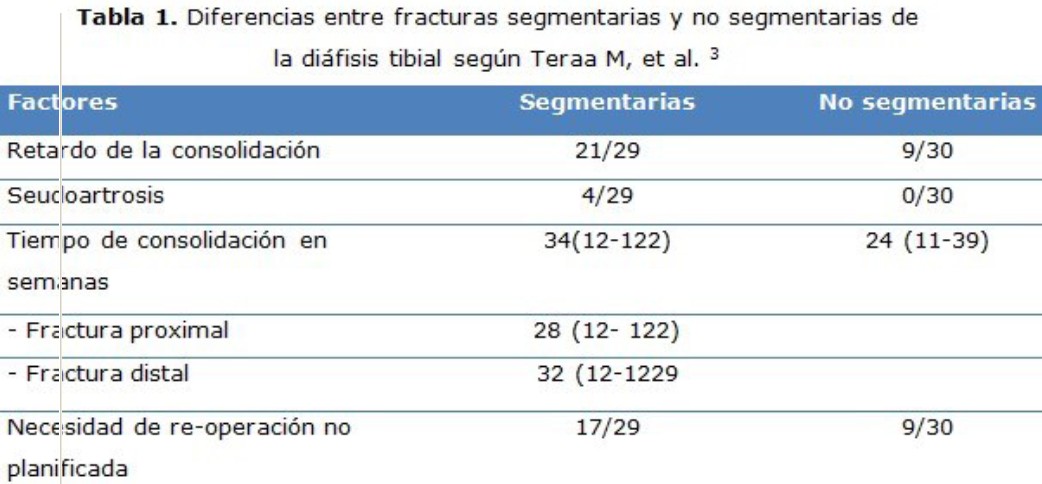Fracturas segmentarias de tibia
Keywords:
FSDT- Fracturas Segmentarias de la Diáfisis TibialAbstract
RESUMENFundamento: las fracturas segmentarias de la diáfisis tibial (FSDT) son afecciones causadas por trauma de alta energía y están por lo general, asociadas a otras lesiones de partes blandas y óseas, que empeoran su pronóstico y hacen más difícil el tratamiento.
Objetivo: profundizar en los elementos esenciales y características de pacientes que sufren de fracturas segmentarias de la diáfisis tibial.
Métodos: se realizó una revisión bibliográfica de un total de 400 artículos publicados en Pubmed, Hinari y Medline, mediante el localizador de información Endnote, de ellos se utilizaron 51 citas seleccionadas para realizar la revisión, 47 de ellas de los últimos cinco años, además se incluyeron cuatro libros.
Desarrollo: se describen los mecanismos de producción más frecuentes, así como las principales diferencias entre las fracturas segmentarias y no segmentarias. En relación a la clasificación, se describió la propuesta por el grupo de Asociación para la Osteosíntesis (AO) en especial la del tipo C y la aplicación de la clasificación de Winquist R y Hansen S. Se hace referencia a los traumas asociados y las complicaciones reportadas en la literatura. Los tipos de tratamientos son por lo general quirúrgicos y pueden ser mediante enclavijado intramedular, uso de fijadores externos y placas subcutáneas.
Conclusiones: las fracturas segmentarias de la diáfisis tibial son lesiones graves, que necesitan de acciones inmediatas, para prevenir o aminorar las complicaciones inmediatas y tardías características de esta lesión.
Background: segmental tibial shaft fractures are affections caused by high energy traumatisms and are generally associated to other lesions of soft and osseous parts that make worse the prognosis and more difficult the treatment.
Objective: to deepen in the essential elements and characteristics of patients who suffer from segmental tibial shaft fractures.
Methods: a bibliographic review of 400 articles published in Pubmed, Hinari and Medline was made by means of the reference management software Endnote. Fifty-one references were selected for making the review, 47 of them were from the last five years and four books were included.
Development: the most frequent mechanisms of production are described, as well as the main differences between segmental and non-segmental fractures. Regarding the classification, the proposal de-scribed by the Osteosynthesis Association, especially type C was described, as well as the application of the classification by Winquist R and Hansen S. The traumas associated and the complications reported in the literature are mentioned. The types of treatment are generally surgical and can be conducted by means of intramedullar nailing, external fixators and subcutaneous plates.
Conclusions: segmental tibial shaft fractures are serious lesions that need to be treated immedi-ately to prevent or reduce the instant complications and the belated characteristics of this lesion.
Downloads

Downloads
Published
How to Cite
Issue
Section
License
Copyright: Camagüey Medical Archive Magazine, offers immediately after being indexed in the SciELO Project; Open access to the full text of the articles under the principle of making available and free the research to promote the exchange of global knowledge and contribute to a greater extension, publication, evaluation and extensive use of the articles that can be used without purpose As long as reference is made to the primary source.
Conflicts of interest: authors must declare in a mandatory manner the presence or not of conflicts of interest in relation to the investigation presented.
(Download Statement of potential conflicts of interest)
The Revista Archivo Médico de Camagüey is under a License Creative Commons Attribution-Noncommercial-No Derivative Works 4.0 International (CC BY 4.0).
This license allows others to distribute, to mix, to adjust and to build from its work, even for commercial purposes, as long as it is recognized the authorship of the original creation. This is the most helpful license offered. Recommended for maximum dissemination and use of licensed materials. The full license can be found at: https://creativecommons.org/licenses/












 22 julio 2025
22 julio 2025